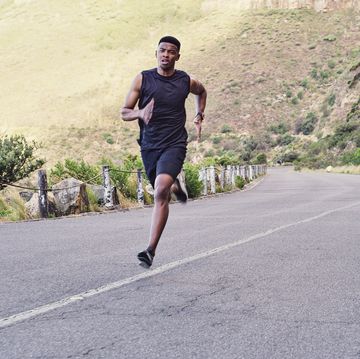The track is another tool that you can put in your training box that helps you build speed and endurance. Find the closest one (typically at your nearest high school or college), and you can run intervals in a traffic-free area. Thanks to the pre-measured loops, you can also check off distance-specific splits without glancing at your watch every couple steps.
If you’re new to track workouts, though, you might be wondering, how long is a track and how many laps is a mile? Well, we’re here to answer all your first-timer questions about the oval, and exactly how to conquer your workouts the first time you step into a lane.
How long is a track and how many laps is a mile?
The track is a great tool for fast running. You can sprint, run intervals, or perform tempo efforts. And the best part: When you know how many laps are in a mile, breaking down each of these workouts becomes easier.
Most outdoor tracks are 400 meters around, as measured in lane 1; that’s slightly less than one-quarter of a mile (0.2485 to be precise).
Here are some other measurements that are helpful to know:
- 100 meters = one straightaway (the part of the track that doesn’t curve at the end)
- 400 meters = about ¼ mile = one lap
- 800 meters = about ½ mile = 2 laps
- 1600 meters = about 1 mile = 4 laps
If you have all lanes available to you, you should know the outside lane is 40 to 50 meters longer than the inside lane. If you have to stay out of the first four lanes for a specific reason, you would reach a mile earlier in your final lap than you would in lane 1.
Are there any track rules to know before you go?
You don’t have to be “fast” to hit the track. In fact, it’s the perfect place for new runners to feel out their training paces in a controlled environment. However, you do need to learn some etiquette.
Check the rules
Many colleges and high schools open their tracks to the public during times when school isn’t in session. Always look for rules before going onto a public track—they might instruct you to run a certain direction on specific days of the week or keep you out of specific lanes, for example. Always plan your workout around open hours, and make sure you don’t interfere with special events. You don’t want to be on a track when the field hockey team is practicing!
Go counterclockwise
Most runners travel counterclockwise on the track. To avoid collisions, you should, too. Again, you may want to check to see if the track has specific rules about what directions you should run on specific days. But keep this track idiom in your back pocket in case you forget the standard direction: “Run fast, turn left.”
Leave the headphones at home
Solo track workouts are one of running’s great joys. You have a completely flat and soft running surface all to yourself. But oftentimes, others will be on the track with you. If you are by yourself, feel feel to get into the zone with your buds and favorite playlist to hopefully achieve a runner’s high. But take the headphones out if others are also on the track.
When multiple runners are hitting different paces in the same space, you need to tune in to what’s going on around you. Listen for callouts such as “track, “on your left,” or “lane 1” as those are all indications that you should clear the way. If you have music cranking, you’ll never hear somebody else coming.
Clear lane one
The innermost lane of the track is typically for the fastest runners. If you’re warming up, cooling down, or running slower, move to an outer lane. (Note: Also, schools sometimes bar the public from using multiple inside lanes—e.g. lanes 1 through 3—to preserve them for their athletes.)
What are the best track workouts and drills?
Now that you know how many laps are in a mile, and the etiquette for a successful day on the track, it’s time to pick your workout. You can easily do a variety of efforts and drills on the track, designed to increase your speed and endurance.
Some popular workouts include mile repeats (running four laps at a prescribed pace, resting, and repeating), Yasso 800s (running 800 meters or two laps, with an equal distance of rest in between, and repeating for four to 10 rounds), and 400-meter repeats (one lap of the track at a push pace, one lap at recovery effort, and repeat for four to 10 rounds). You can also do tempo runs and fartlek intervals at the track.
If you need inspiration, check out these best track workouts for beginners.













